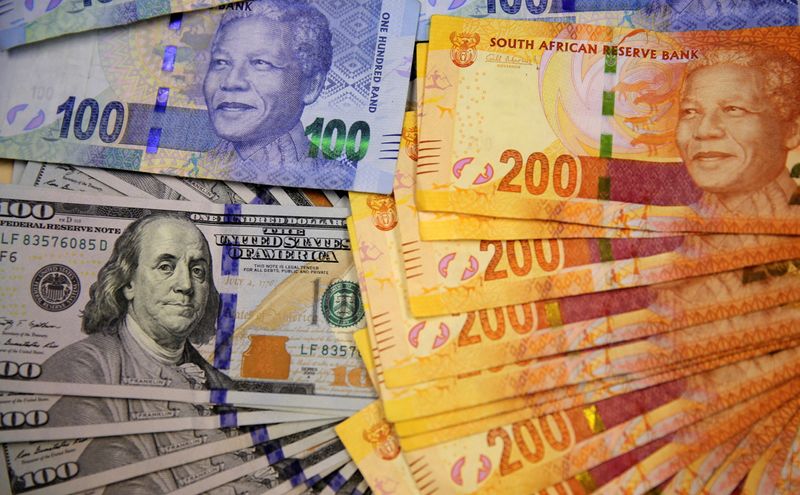(Refiles to fix first graphic, no changes to text)
LONDON (Reuters) – Finding themselves at the sharp end of a global inflation shock, emerging market central banks are expected to raise interest rates at a pace not seen in more than a decade — moves bound to aggravate debt problems and hurt equity markets.
Soaring price pressures have seen rate hike expectations shift up even for central banks in the United States, Australia and Britain. The subsequent rise in global borrowing costs will be highly unwelcome to developing countries, many of which are struggling to return to pre-pandemic economic output levels.
Battling soaring food and energy costs, many emerging central banks are already in aggressive rate-hike mode.
And as policy tightening expectations rise for the United States, Britain and other advanced nations, money markets are wagering emerging markets will have to ramp up the hiking pace.
“Many emerging markets are in an increasingly difficult spot,” said Manik Narain, head of emerging market strategy at UBS, pointing to expectations that the current inflation shock would prove to be far more permanent in developing economies than in the United States or Europe. “Markets are pricing in a much faster tightening cycle in emerging than in developed markets, it’s a difficult balancing act.”
(Graphic: EM inflation overshoots targets: https://fingfx.thomsonreuters.com/gfx/mkt/zgvomkwxdvd/Emerging%20markets%20inflation%20and%20policy%20rates.PNG)
South Africa, Mexico, Poland and Turkey are all expected to raise rates by more than 200 basis points in the coming 12 months, JPMorgan calculates. Latin America will see some of the biggest increases, with Brazil expected to hike by more than 600 bps and Colombia more than 400 bps.
Data shows price pressures outstripping interest rates in a number of big economies including South Africa, Mexico, Brazil and Turkey. Across all regions, underlying inflation trends are rising strongly. Mexico’s core inflation posted its highest biweekly increase nL1N2RA1LX for a first half of October since 1999 while Russia’s inflation soared to near 8% despite bumper rate hikes.
And with droughts haunting big agricultural producers such as Mexico and Argentina, food inflation is at the forefront of policymakers’ minds, says UBS’ Narain.
“If we start to see a lot of pressure from food prices, policy makers will find themselves in a very tight spot.”
(Graphic: Emerging market inflation rates and forecasts for 2022: https://graphics.reuters.com/EMERGING-INFLATION/zjpqkerzrpx/chart.png)
Possibly money markets are being too exuberant. Barclays head of economics research, Christian Keller, expects emerging as well as developed market central banks to deliver fewer interest rate hikes than priced, but he warned nonetheless that “when your inflation expectations start to deteriorate, that is when you need to act as a central bank”.
EMERGING CONUNDRUM
It is a replay of the age-old conundrum for emerging markets – the need to tighten policy just as economies need extra support.
Preserving a real yield differential over U.S. Treasury yields is also needed to keep foreign investors in domestic markets and prevent capital outflows. Swift central bank action may have helped keep many emerging currencies on a relatively steady footing in 2021, helping cap imported inflation.
So in a year when the U.S. dollar has appreciated almost 5%, the Brazilian real, backed by a cumulative 575 bps in rate increases, has lost more than 8% while the rouble has actually firmed 3.2% on 325 bps of rate hikes.
“Hiking early not only helped with the inflation side of things, but also helps prevent a 2013-taper tantrum style scenario, and certain central banks have gotten on top of this and seen their currency do okay,” said Robert Ojeda-Sierra at Fitch Ratings.
In contrast, markets that haven’t adjusted their monetary policy enough have suffered: Turkey’s lira, hit by interest rate cuts in the face of high inflation, has dropped more than 20% this year.
(Graphic: EM interest rate hikes priced in: https://fingfx.thomsonreuters.com/gfx/mkt/zjvqkwqwavx/Emerging%20market%20hikes%20priced%20in.PNG)
Most central banks acknowledge that the only way is up.
In October, Russia opted for a 75-basis-point hike but the central bank had considered a 100 bps increase which Governor Elvira Nabiullina said could not be ruled out in the future.
GROWTH HIT
But if currencies have been spared the pain, the impact of higher interest rates is being felt elsewhere.
Emerging equities are treading water in 2021, contrasting with 20%-plus gains on the S&P 500 or global stocks’ 16% increase.
With nominal growth rates in major emerging markets such as Brazil and South Africa dipping back below interest rates, those pressures will come back to the fore.
Bond markets will see debt servicing and borrowing costs rise, all the more painful after the pandemic-era increase in debt burdens. Yields on JPMorgan’s local emerging debt index have risen more than 150 basis points this year.
Central banks might be poised to act but ultimately the outcome hinges on how soon and fast the U.S. interest rates rise. Labour market price pressures are likely to spur more tightening than those from energy or commodity prices.
(Reporting by Karin Strohecker, additional reporting by Andrey Ostroukh in Moscow and Marc Jones in London; Editing by Emelia Sithole-Matarise)


























